Crane
Engineering
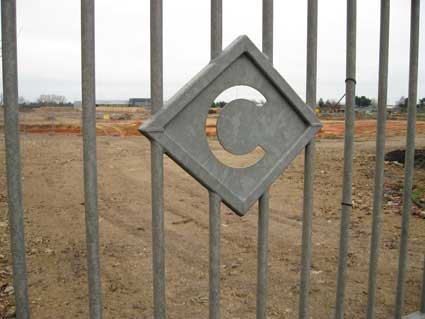 2013 images
2013 images
Founded in Chicago in 1855 by Richard Teller Crane, Crane
Company is a diversified manufacturer of
highly engineered industrial products under five business segments:
Aerospace & Electronics, Fluid Handling, Engineered Materials,
Merchandising Systems, and Controls with approximately 12,000 employees
worldwide.
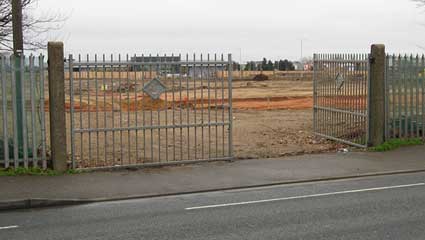
The site in Nacto Road is 44 acres in area and was cleared in
2011/12. There were two pairs
of gates on Nacton Road, but by the
time of these images in January 2013 the pair nearest to The Thrasher
public house had been removed and a service road cut through.
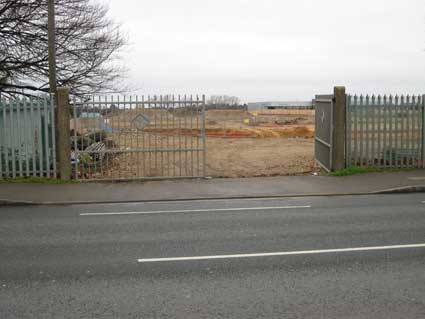
In the distance can be seen
the grey Waitrose supermarket block.
This area has been dubbed Futura Park although we can't see any obvious
connection with the sans-serif Futura typeface designed in 1927 by Paul
Renner, which was based on geometric shapes that became representative
of visual elements of the Bauhaus design style of 1919–1933.
The
official opening of the development site on Thursday November 1 2012 of
James Bennett Avenue
and Crane Boulevard showed that the names of the roads were chosen as a
nod
to the site’s history. Crane Boulevard, which connects with
Nacton Road, is named after Crane
Co of Chicago, by that time a global concern. It was the engineering
company that bought the site in 1919 and
operated a foundry there for 83 years. James Bennett Avenue, which
links with Ransomes Way, is named after the engineer who established
Crane Co’s UK operations during the 1920s. The foundry closed
in
2008 when production was moved to China.
[UPDATE 11.4.2016: John Barbrook spent the majority of
his professional life with Crane in Ipswich:
"During the peak years of their size during the late 60s to early 80s
they produced not only hundreds of thousands of bronze, iron and steel
fluid flow control valves over a very wide range of sizes, but also
equally large numbers of heating boilers and radiators. However, the
tonnage of even this massive output was dwarfed by the 1½ million or so
iron pipe fittings which they cast and machined each week.
Like most manufactured goods, the majority of the products had the
CRANE name on them somewhere. But in the case of the iron pipe
fittings, they had traditionally always had the letter C contained in a
diamond-shaped lozenge cast into them (and in most cases also the BS
kite mark).
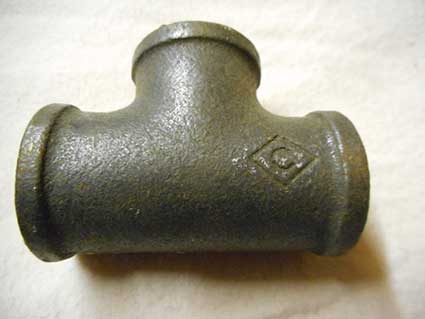
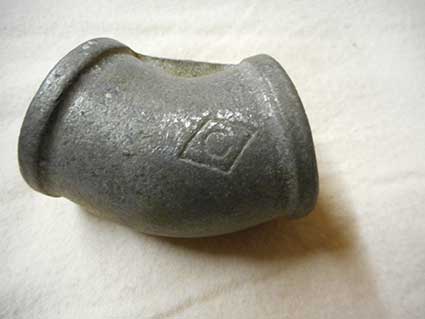
Photographs courtesy John Barbrook
Over our years of holiday travel around Europe, America and Canada,
often much to the annoyance of my wife, whenever I spotted any exposed
pipe-work, I triumphantly looked for the Crane ‘C’. I found them 2000
feet down in a Derbyshire coalmine, and in ‘dry-riser’ pipe work at
both the top of the spire of Salisbury cathedral and the top of the
Eiffel tower in Paris.
The front of the premises in Nacton Road – unlike any other engineering
plant I knew – always had well manicured lawns and flower beds in
front, with a line of mature flowering cherry trees, a sight worth
seeing when they were in bloom. However, for security reasons, there
had to be a substantial fence – pity. Around 30 years ago (I think),
the ageing steel mesh fence was replaced by a more business-like
spike-topped one, sadly making the place look more like Colditz. I was
unable to persuade them to place the new fence on the factory side of
the gardens. The Nacton Road area was not renowned for strict civil
obedience in those days by some sections of the population, and I think
there were fears of vandalism.
Touchingly, however, the Crane diamond C lozenge was set in the centre
of the new gates. Two of these gates are still there in the remaining
section of fence [as shown above] which the site developers have not
yet managed to rip down. All the gardens and trees were of course swept
away (along with the original foundation stone laid by in 1921 which I
asked them to save).
I have attached a shot of just two pipe fittings of the many
hundreds of types and sizes." Many
thanks to John for this "horse's mouth" account of Crane Company.]
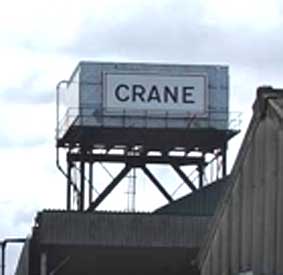
For many
years the Crane sign was visible from the road
high up on a water tower. Never the most attractive of industrial
complexes, it has all gone now. For a photographic tour of the
abandoned site before demolition, try the Derelict Places website (see Links).
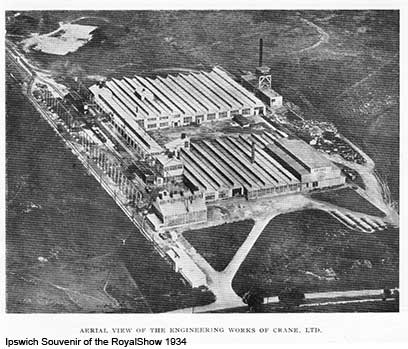
Above, the Crane engineering works in 1934 from the air – the Ipswich
airport
was nearby; it was virtually a greenfield site, by the look of things.
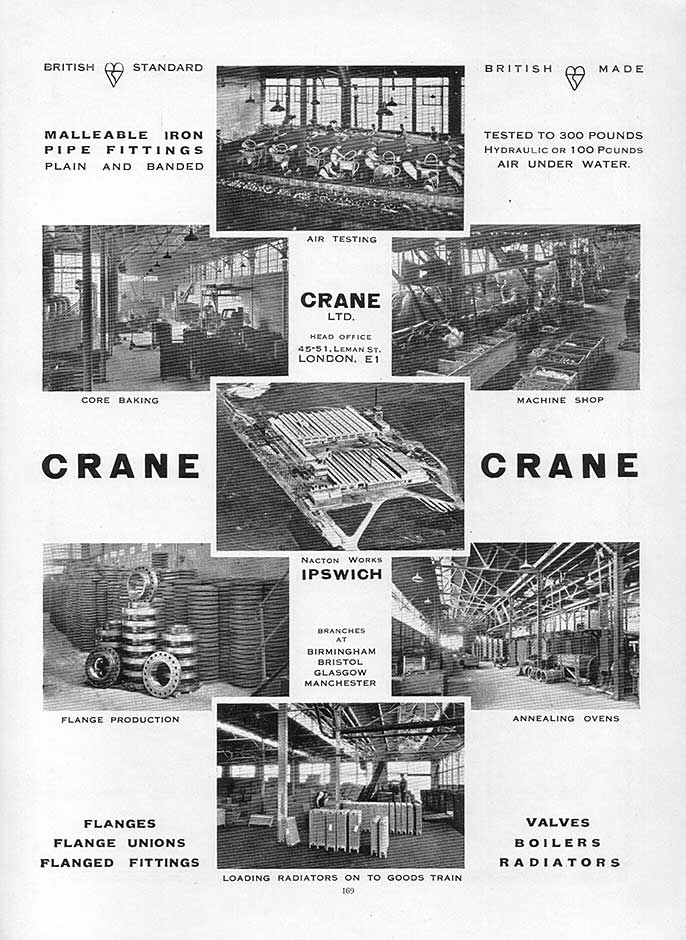 1936 advertisement
1936 advertisement
The other place in Ipswich where Crane Co is commemorated is the small
garden at the top of Upper Orwell Street.
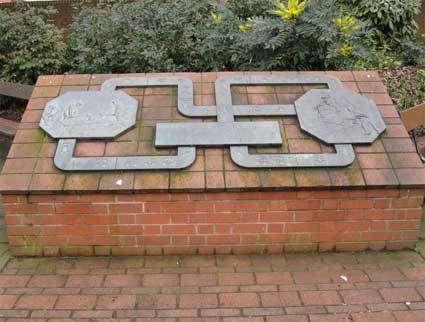
The central plaque reads:
'THIS GARDEN WAS
OPENED ON 30 MARCH 1977 BY THE MAYOR OF IPSWICH
COUNCILLOR
H.R. DAVIS
IT WAS
PRESENTED TO IPSWICH BY CRANE LIMITED
MANUFACTURERS OF
MALLEABLE
IRON PIPE FITTINGS AND BRONZE AND STEEL VALVES
IT MARKS
THE FIFTIETH ANNIVERSARY OF THE FIRST METAL
POURED
IN THE
MALLEABLE FOUNDRY OF THEIR IPSWICH FACTORY
AND IS IN
APPRECIATION OF THE SUPPORT GIVEN BY THE
TOWNSPEOPLE
TO THE COMPANY OVER THE YEARS.'

The octagonal reliefs on either side show molten metal being poured and
the lettering:
'DISA
MATIC'
in the right hand background.
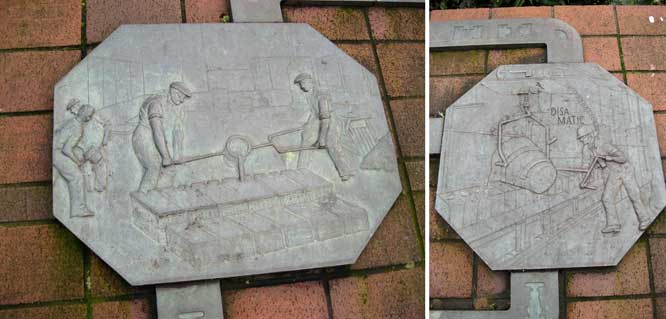
John A Green was born in Ipswich in 1932, son of a Master Mason. He
gained his Master Mason Certificate in 1951. He studied at Ipswich
School of Art (1951-54) and the Royal College of Art (1954-57) where he
was encouraged by Prof. John Skeaping. From
1957 until 1959 John was assistant to Jacob Epstein. His main run of
work is the restoration of church monuments. His work in Ipswich is
this bronze panel on a brick plinth, symbolising the technical
development in foundry methods
during the fifty years since the firm Crane's came to Ipswich.
Crane
Co history
The 'Crane' name continues in the name of the hill on London Road
coming out of the town towards Colchester just after it crosses the
railway line. This stretch of road is known to locals as 'Crane Hill'
(although no signs are visible, the name is certainly there on street
maps – it's the home of a milepost) which
relates to Crane Hall, home of the engineering family. The
Victorian brick encasement completely hides the original 16th century
timber framed structure. Later development of the site for residentail
use resulted in the rendering and painting of Crane Hall as well as
internal modernisation as offices. British Listed Buildings (see Links)
shows Crane Hall as a Grade II structure standing close to Kelly Road
on the
north-west of London Road (the Dickens Road side) and we recall that
Thompson & Morgan occupied these offices. This famous
seedsman's
company started in the mid-19th century in a small garden behind a
baker's shop in Tavern Street, Ipswich, tended by William Thompson, the
baker's son, who specialised in raising rare plant species. That
company still trades today from Poplar Lane on the western edge of
Ipswich.
Cranes in Suffolk can be traced back to the Norman Conquest and ensuing
settlements in East Anglia; by the 15th centry it was a wealthy family
with extensive estates. Some members of the Crane family emigrated to
Massachusetts in eastern America in 1636 accompanying John Winthrop.
Winthrop became the first governor and
Timothy and Maria Crane (née Ryerson) is recorded in New Jersey at
around
1730. They appear to be descendants of the Ipswich family. In 1732 they
had a son, Richard Teller Crane. He eventually founded what was to
become Crane Co in 1855 in Chicago. In 1855 he founded the R.T. Crane
Brass & Bell Foundry in Chicago. Crane produced
valves, fittings, and specialty castings for a growing
industrial
America.
The site on Nacton Road in Ipswich was bought in 1919 by Crane Co of
Chicago, then owned and run by Richard Teller Crane Junior (who also
became a philanthropist to our town) and a
massive factory initially using American machinery and know-how was set
up. Richard Teller Crane Jnr and his father before him lived in
Ipswich, Massachusetts in the USA, where the family built a large
mansion which stands today. It would seem that the Ipswich,
Suffolk factory site location was acquired mostly due to an
acknowledgement of the family ancestry.
During its 90 years in Ipswich it employed thousands of local people
and during the 1970s became the largest manufacturing employer (around
3,000) in Ipswich, alongside other more locally established companies
like Ransomes Sims & Jefferies,
Ransomes & Rapier and
Reavells.
Similar Crane subsidiaries were established in most European countries
and in Australia.
[UPDATE 15.8.2013: "Dear Sirs,
I don't know if this is any interest to you but my Great grandfather
James Henry Moore, married in Ipswich in 1865, had his marriage
certificate witnessed by George Joseph Crane and Harriet Crane. Given
that g. grandfather was an architect surveyor I
wonder if he
was engaged by the Cranes. If you know of any way of looking more
deeply into this possibility I would be keen to know. Thanks for your patience, David Moore."]
See also our Lettered castings
index page.
Home
Please email any comments
and contributions by clicking here.
Search Ipswich
Historic Lettering
©2004
Copyright
throughout the Ipswich
Historic Lettering site: Borin Van Loon
No reproduction of text or images without express written permission
 2013 images
2013 images





 1936 advertisement
1936 advertisement

